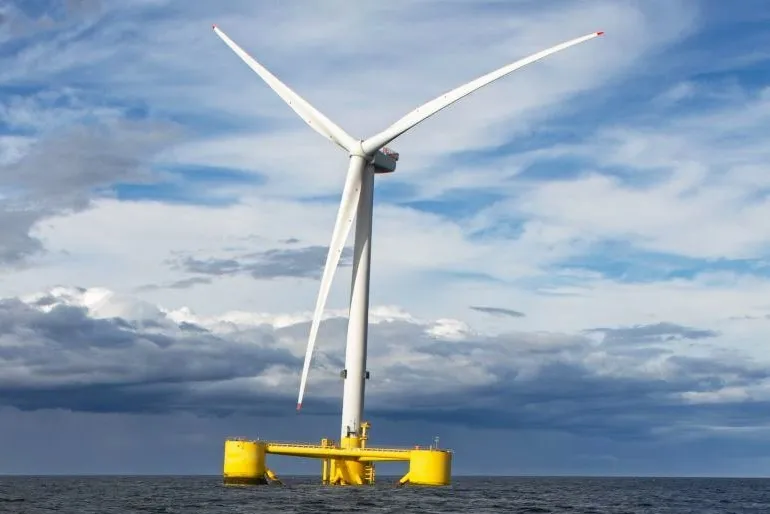Boost for floating offshore wind as Celtic Sea 'stepping stone' project gets green light
The UK's next CfD auction is likely to see bids from a clutch of pre-commercial floater projects

Offshore wind developers Flotation Energy and Cobra have received full planning consent for their 100MW White Cross floating offshore wind project, in time to allow participation in the UK's next allocation round offering Contracts for Difference (CfDs) for renewable energy.
The pre-commercial project, to be located about 52 kilometres off the coast of Devon, will consist of six to eight floating turbines.
It is now eligible to bid for part of the CfD budget set aside for floating offshore wind projects in an auction expected to open later this month.
The White Cross consortium submitted planning applications in 2023 and has now been granted full onshore and offshore planning approval, including grid connection works.
The applications, which were the subject of three rounds of public consultation, were submitted to the North Devon Council and the Marine Management Organisation (MMO).
The developers provided assurances that onshore export cables will be completely buried underground for their entire length in an area of natural beauty and intense tourism.
These areas include the Braunton Burrows Special Area of Conservation (SAC) dune system and the Taw-Torridge estuary.
White Cross is one of three Celtic Sea floating offshore wind projects vying for special offtake contracts.
Planning documents show that White Cross is planning to use steel semi-submersible floating structures, with catenary mooring systems, but the rating of the turbines has not yet been decided.
The developers are already partners on the Kincardine project in Scotland, where Principle Power's semisubmersible hulls provide the floating platform.
Celtic Sea rivals
A second project 100MW floating offshore wind project, called Erebus, is backed by Blue Gem Wind, a joint venture between TotalEnergies and Simply Blue Group. It will feature seven 14MW turbines using Principle Power's WindFloat platform.
This project is located about 40km off the Pembrokeshire coastline of Wales and received the necessary Section 36 planning consents from Welsh Ministers in 2023.
The third project, Llyr 1 and Llyr 2, comprises two different floating offshore wind sites under development by Floventis/Cierco Energy, each with a capacity of 100MW.
Last month, Cierco Energy signed a memorandum of understanding with UK floater specialist Marine Power Systems, with a view to using that company's technology on one of the Llyr projects.
The patented PelaFlex design is said to reduces weight, material use and installation timelines and support supporting regional supply chain and port use through a modular design.
The Llyr projects are still in the marine licensing and Section 36 consent phase but the consortium has overcome objections from the UK Ministry of Defence regarding the possible siting of an export cable in a sensitive area for marine operations.
The objections were withdrawn when the MOD was given assurances, but full consent is still pending.
Lease round
This result was hailed as a significant development because most of the UK's pipeline of floating offshore floating wind projects had been awarded in Scottish waters up to this point, due to the success of the ScotWind and INTOG rounds.
While awarding capacity to more gigascale projects was welcomed by developers who want offshore floating wind gain critical mass for port investments, the difficulties that the sector has faced in scaling up this fledgling technology has led to calls for the UK to foster more pre-commercial projects to pave the way.
The UK government gave a nod in this direction last month when it published the final terms and conditions for the next CfD auction round, known as AR7.
The government said it will also set appropriate budget and auction parameters to facilitate its intention to support multiple test and demonstration floating offshore wind projects in AR7.
Other smaller scale floating offshore wind projects in the frame for AR7 include the Pentland and Salamander projects in Scotland — under development by Copenhagen Infrastructure Partners (CIP) and Orsted respectively — and also EDF's Blyth 2 project off the northeast of England.
The Salamander project, where Orsted is partners by Simply Blue Group, and Subsea7, was awarded Section 36 planning consent and associated marine licences just two weeks ago.
Stepping stone
"White Cross is a stepping stone project that is pivotal to the Crown Estate’s ambitions to scale-up and commercialise floating energy technologies in the Celtic Sea," the developers behind the project stated this week.
“The UK is already a leader in floating offshore wind technology, but until now this has only been via projects in Scottish waters," said White Cross senior project manager Sam Park.
"This decision gives us a valuable opportunity to harness this pioneering technology to help deliver the energy transition in the south west of England. By doing so, we will seek to spark the development of a specialised local supply chain, creating jobs whilst providing 135,000 homes with renewable energy."
(Copyright)